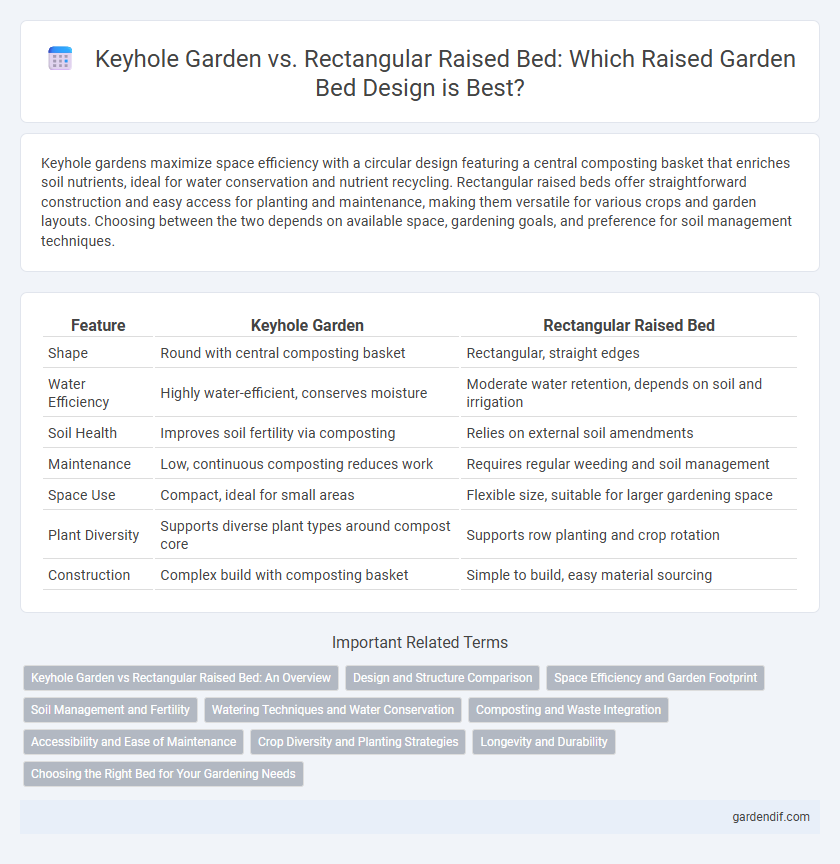
Keyhole Garden vs Rectangular Raised Bed Illustration
Keyhole gardens maximize space efficiency with a circular design featuring a central composting basket that enriches soil nutrients, ideal for water conservation and nutrient recycling. Rectangular raised beds offer straightforward construction and easy access for planting and maintenance, making them versatile for various crops and garden layouts. Choosing between the two depends on available space, gardening goals, and preference for soil management techniques.
Table of Comparison
| Feature | Keyhole Garden | Rectangular Raised Bed |
|---|---|---|
| Shape | Round with central composting basket | Rectangular, straight edges |
| Water Efficiency | Highly water-efficient, conserves moisture | Moderate water retention, depends on soil and irrigation |
| Soil Health | Improves soil fertility via composting | Relies on external soil amendments |
| Maintenance | Low, continuous composting reduces work | Requires regular weeding and soil management |
| Space Use | Compact, ideal for small areas | Flexible size, suitable for larger gardening space |
| Plant Diversity | Supports diverse plant types around compost core | Supports row planting and crop rotation |
| Construction | Complex build with composting basket | Simple to build, easy material sourcing |
Keyhole Garden vs Rectangular Raised Bed: An Overview
Keyhole gardens maximize water efficiency and nutrient recycling through their circular design with a central composting basket, promoting sustainable gardening in limited spaces. Rectangular raised beds offer straightforward construction and easier access for planting, making them ideal for traditional vegetable cultivation and crop rotation. Choosing between a keyhole garden and a rectangular raised bed depends on goals such as water conservation, space utilization, and ease of maintenance.
Design and Structure Comparison
Keyhole gardens feature a circular design with a central composting basket, optimizing nutrient recycling and water retention, while rectangular raised beds offer a straightforward, space-efficient layout ideal for row planting and easy access. The compact, curved structure of keyhole gardens facilitates intensive planting and minimizes water loss, contrasting with the more traditional, elongated form of rectangular beds that support crop rotation and modular expansion. Both designs enhance soil drainage and aeration, but keyhole gardens promote a self-sustaining ecosystem through integrated composting, whereas rectangular beds rely on regular soil amendments.
Space Efficiency and Garden Footprint
Keyhole gardens maximize space efficiency by integrating a central composting basket, allowing gardeners to access soil and nutrients with minimal footprint, ideal for small or irregular areas. Rectangular raised beds offer straightforward layout and expansion options but typically require more ground space, making them less efficient in confined gardens. Choosing between the two depends on available garden area, with keyhole designs optimizing nutrient recycling in compact spaces compared to the broader footprint of rectangular beds.
Soil Management and Fertility
Keyhole gardens optimize soil fertility through a central composting basket that continually enriches the surrounding soil with organic matter and nutrients, promoting superior moisture retention and microbial activity. Rectangular raised beds require regular addition of compost and amendments across the entire bed to maintain soil fertility, which can lead to uneven nutrient distribution and increased labor. The circular design of keyhole gardens enables efficient nutrient cycling and targeted soil management, enhancing plant growth compared to traditional rectangular beds.
Watering Techniques and Water Conservation
Keyhole gardens utilize a central composting basket that naturally waters surrounding plants through a deep watering technique, promoting efficient water absorption and minimizing runoff. Rectangular raised beds typically rely on surface watering that can result in uneven moisture distribution and higher evaporation rates. Keyhole designs enhance water conservation by creating a self-watering system that maintains consistent soil moisture with less frequent watering compared to traditional rectangular raised beds.
Composting and Waste Integration
Keyhole gardens excel in composting and waste integration by incorporating a central composting basket that continuously breaks down kitchen scraps and organic waste, enriching the surrounding soil with nutrients. Rectangular raised beds lack this integrated composting feature, requiring separate compost bins and manual amendment of soil, which can be less efficient in nutrient recycling. The circular design of keyhole gardens maximizes space for organic matter decomposition, enhancing soil fertility and moisture retention compared to traditional rectangular beds.
Accessibility and Ease of Maintenance
Keyhole gardens offer enhanced accessibility through a central composting basket, allowing gardeners to reach all parts without stepping into the bed, which reduces soil compaction. Rectangular raised beds require more frequent bending and stretching to access plants, which can challenge gardeners with mobility issues. The circular layout of keyhole gardens simplifies maintenance by concentrating watering and composting efforts, improving efficiency and plant health.
Crop Diversity and Planting Strategies
Keyhole gardens maximize crop diversity by incorporating a central composting basket that enriches soil nutrients, allowing simultaneous growth of deep-rooted and shallow-rooted plants in concentric patterns. Rectangular raised beds support straightforward crop rotation and companion planting, optimizing space for row crops and layered planting of vegetables and herbs. Both systems enhance intensive planting strategies but differ in spatial design, with keyhole gardens favoring circular diversity and rectangular beds supporting linear crop organization.
Longevity and Durability
Keyhole gardens, constructed with natural materials like stone and compost layers, offer exceptional longevity through sustainable decomposition and regeneration processes. Rectangular raised beds made from rot-resistant wood or metal provide durable structural integrity, resisting weathering and decay for many years. Choosing materials such as cedar or galvanized steel enhances the lifespan of raised beds, with rectangular designs often requiring less maintenance compared to keyhole gardens.
Choosing the Right Bed for Your Gardening Needs
Choosing the right bed for your gardening needs depends on space efficiency and water conservation. Keyhole gardens feature a circular design with a central compost basket, ideal for small spaces and enhancing soil fertility through continuous organic matter recycling. Rectangular raised beds offer straightforward layout options, easier crop rotation, and scalability, making them suitable for gardeners prioritizing accessibility and structured planting.
Keyhole Garden vs Rectangular Raised Bed Infographic

 gardendif.com
gardendif.com